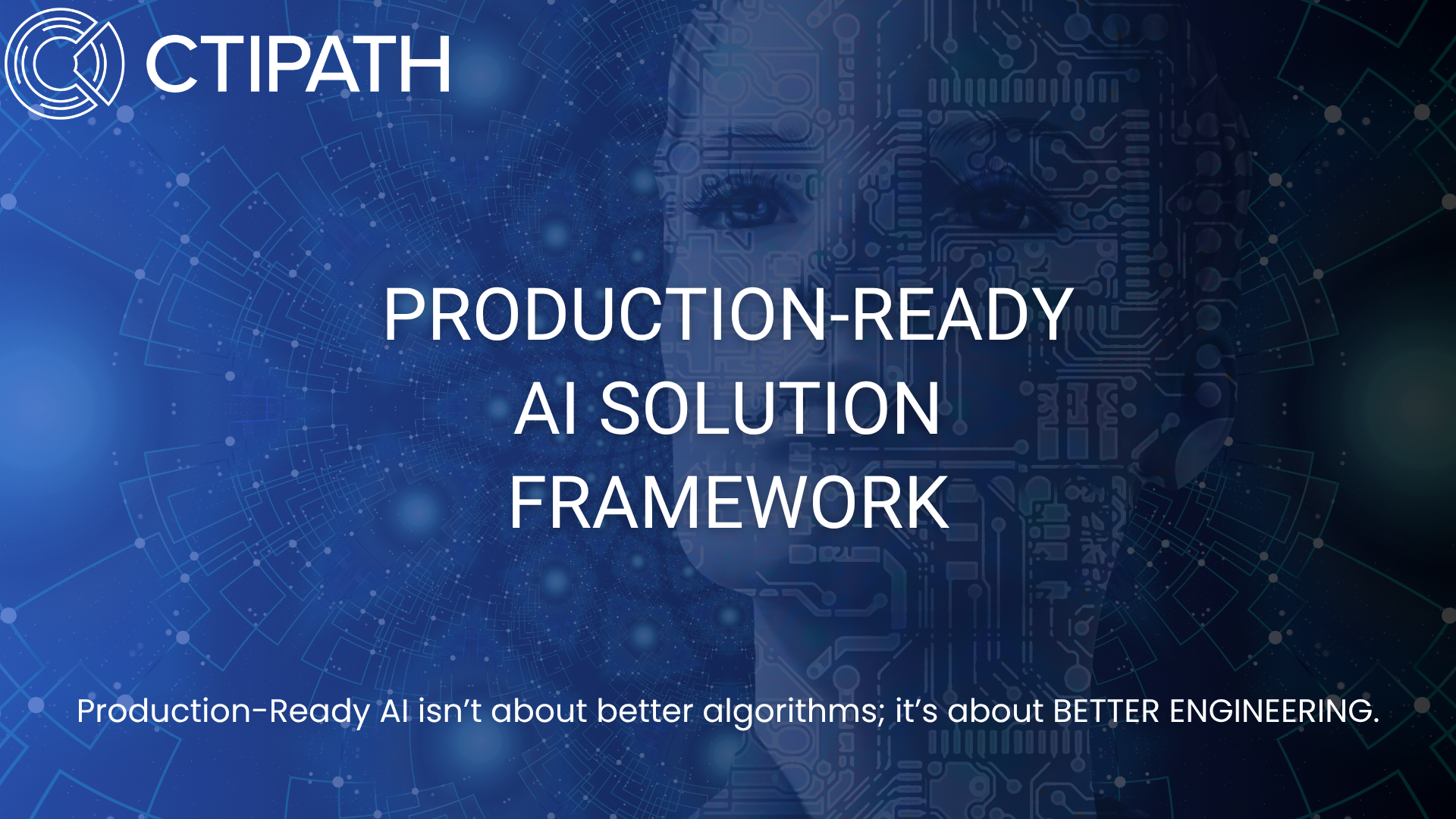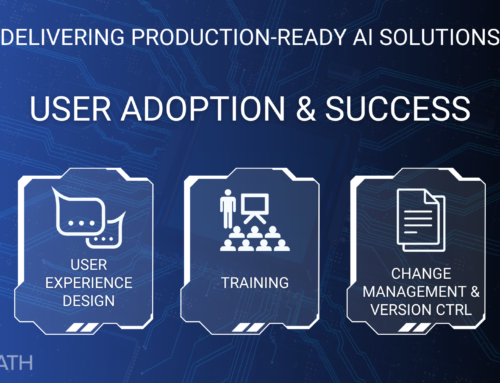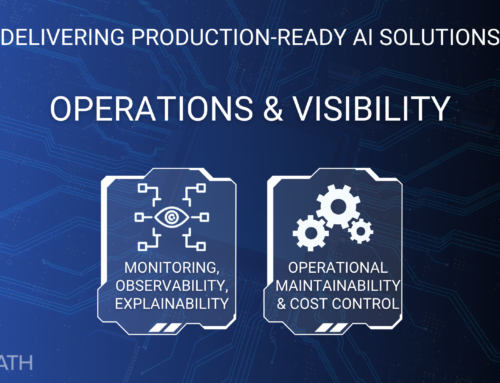What Production-Ready AI Looks Like
Most AI projects fail not because the technology doesn't work, but because nobody planned for what happens after the demo.
Open LinkedIn and you'll see the same pattern repeating: posts celebrating ChatGPT's latest capabilities, screenshots of impressive AI-generated content, and endless debates about vector databases. The technical discussions are sophisticated, the demos look polished, and the excitement feels genuine.
But there's a problem. The same people sharing these posts often work at companies where AI initiatives quietly die in committee meetings, where promising pilots never scale beyond small teams, and where impressive prototypes somehow never become the business tools everyone expected.
Why Technical Discussions Miss the Point
The AI conversation focuses heavily on the wrong parts of the problem. Yes, choosing between different language models matters. Yes, your database architecture affects performance. But these technical components – the ones generating the most discussion online – represent maybe 20% of what determines whether an AI system actually works in a business.
The other 80%? The unglamorous infrastructure work that keeps systems running when hundreds of people use them simultaneously, when things go wrong at 2 AM, and when your company's sensitive data needs protection.
This isn't unique to AI. Every technology goes through this cycle. In the early days of web development, technical forums buzzed with debates about programming languages and database choices. Meanwhile, the companies actually succeeding online were the ones who figured out server architecture, security protocols, and customer support systems.
AI is having its moment of technical fascination while the practical implementation problems get less attention.
What Actually Breaks AI Systems in Production
Performance collapse under normal usage. Your chatbot works perfectly when three people test it. Deploy it to handle customer service inquiries and watch response times crawl as concurrent users overwhelm the system. The AI model isn't the bottleneck; it's the lack of proper request queuing, load balancing, and resource management.
Security gaps that create liability. AI systems process sensitive information differently than traditional software. They might cache conversation fragments, log user inputs for debugging, or inadvertently expose data through model outputs. A law firm testing an AI contract analyzer discovers their confidential client information is sitting in server logs that multiple vendors can access.
Integration nightmares with existing systems. The demo AI works great as a standalone tool. But your business runs on interconnected systems: CRM platforms, accounting software, inventory management, email systems. Getting the AI to work smoothly within this ecosystem often requires more engineering effort than building the AI functionality itself.
Compliance failures that shut down projects. Healthcare organizations discover their AI violates HIPAA requirements. Financial services find their system doesn't meet regulatory audit standards. The AI technology works fine, but the surrounding architecture never addressed industry-specific requirements.
Operational complexity that overwhelms teams. Someone needs to monitor system performance, update models, handle error conditions, and maintain security protocols. Many organizations deploy AI systems without considering who will do this ongoing work or how they'll get trained.
The Elements That Determine Success
While AI enthusiasts debate model capabilities, production systems succeed or fail based on comprehensive foundations that address every aspect of real-world deployment. In order to build AI systems that perform well in production, CtiPath developed the "Production-Ready AI Solutions Framework".
The framework includes Foundation & Planning, Data & AI Core, System Integration & Reliability, Operations & Visibility, and User Adoption & Success.
Foundation & Planning means more than choosing the right AI model. Business Value & Cost Management establishes clear metrics that justify continued investment, not vague goals like "improve efficiency," but specific targets like "reduce customer response time by 40% while maintaining satisfaction scores above 4.2." Compliance & Governance builds regulatory requirements into the architecture from the beginning. Scalable Infrastructure handles growth without system redesigns. Comprehensive Security protects both operations and competitive advantage through multi-layered protection including role-based access controls and audit capabilities.
Data & AI Core encompasses Data Pipeline Integrity that handles messy enterprise data with robust validation and processing. AI Model Management addresses the full lifecycle including ethical practices and bias detection. Performance & Resource Optimization maintains consistent response times under all conditions, not just optimal ones.
System Integration & Reliability ensures Integration Architecture works seamlessly with existing business systems. Resilience & Fault Tolerance handles failures gracefully rather than catastrophically. Disaster Recovery protects business continuity when things go seriously wrong.
Operations & Visibility provides Monitoring, Observability, & Explainability provides real-time system health, performance tracking, and the transparency needed to understand AI decision-making. Operational Maintainability & Cost Control designs systems for long-term management by actual human teams.
User Adoption & Success focuses on User Experience Design that drives real adoption, not just impressive demos. Training programs prepare people to use new capabilities effectively. Change Management & Version Control helps organizations adapt to AI integration while maintaining deployment governance and rollback capabilities.
These elements work together. Miss one and the others can't compensate. It's like building a car. You need more than a powerful engine if you want reliable transportation.
Why the Gap Between Demo and Production Is So Large
Building impressive demos requires different skills than deploying production systems. Creating a working chatbot prototype needs understanding of natural language processing and interface design. Deploying that chatbot to serve thousands of customers requires infrastructure architecture, security protocols, performance optimization, compliance knowledge, integration expertise, monitoring systems, and operational procedures.
The prototype takes a talented developer a few weeks. The production system requires the engineering discipline typically found in teams that have built enterprise software for years.
This creates a knowledge gap in the AI field. Many people understand the technology deeply but have limited experience with production deployment challenges. Others understand enterprise systems but are still learning AI capabilities. The intersection – people who understand both – is smaller than the market demand for production-ready AI systems.
Real Business Requirements Beyond Technical Specs
Business leaders asking about AI implementation are really asking about risk management. They've seen the demos and read the case studies, but they've also heard about projects that consumed budgets without delivering results, security breaches that exposed sensitive information, and systems that worked perfectly until they suddenly didn't.
AI systems create new categories of risk. Unlike traditional software that processes data and discards it, many AI services historically used customer interactions as training material. Your strategic planning sessions could theoretically help competitors who use the same AI service later. As detailed in our analysis of "AI Data Privacy in the Cloud", modern platforms like AWS Bedrock address these concerns, but you need to understand the implications and configure systems appropriately.
Every AI interaction also leaves digital footprints that require careful management. As we explore in "The AI Data Trail Challenge", logs are essential for maintaining reliable service but can become liability without proper handling. A healthcare AI might inadvertently log protected patient information alongside system diagnostics.
These aren't theoretical problems. They're operational realities that must be addressed through architectural decisions made before development begins.
An Engineering Approach to AI Implementation
Organizations succeeding with AI make engineering-driven decisions based on proven results rather than vendor promises or industry hype.
Our approach, described in "See It Work Before You Buy It", starts with working demonstrations that answer fundamental questions: "Will AI actually solve this problem for us?" followed by "Can this work in our environment?" Only after proving value at each stage do you invest in full deployment.
The process begins with understanding business challenges before exploring technology capabilities. As we emphasize in "AI and Automation Solutions That Actually Solve Problems", successful implementation requires mapping actual pain points first: Which processes create bottlenecks? Where do errors cost money? Which tasks consume disproportionate resources?
Only after identifying specific problems do we explore whether AI can deliver meaningful impact, and which technologies will work best for your particular environment and constraints.
Questions That Reveal Production Readiness
When evaluating AI solutions, the technical specifications matter less than the production architecture. The revealing questions aren't "Which language model do you use?" or "How accurate is your AI?"
Instead, ask:
- How does the system perform when hundreds of users access it simultaneously?
- What happens when critical components fail?
- How do you handle data privacy and regulatory compliance?
- What does ongoing monitoring and maintenance look like?
- How does this integrate with our existing business systems?
- What training and organizational change support do you provide?
- How do you monitor and optimize ongoing operational costs?
The depth and specificity of answers reveal whether you're evaluating a demo-quality prototype or a business-ready solution.
Production-ready systems are engineering products, not research projects. They're built by teams who understand that impressive technology only creates value when supported by infrastructure designed for reliable operation over time.
Moving Past the Excitement to Implementation
The AI transformation is real, but capturing its benefits requires moving beyond demonstrations to systems that serve your business reliably. The difference between promising pilots and transformative business tools lies in production architecture that addresses every aspect of real-world deployment.
AI discussions will continue celebrating technical achievements and impressive capabilities. But business leaders need partners who understand that successful AI deployment is an engineering discipline requiring the same rigor applied to other critical business systems.
The question isn't whether AI can help your organization. It's whether you're approaching implementation with sufficient engineering discipline to turn possibilities into operational realities. That means looking beyond demos to understand complete production systems, working with teams experienced in enterprise deployment, and investing in the comprehensive architecture required for long-term success.
The technology works. The question is whether your implementation approach matches the sophistication of the opportunity.
















